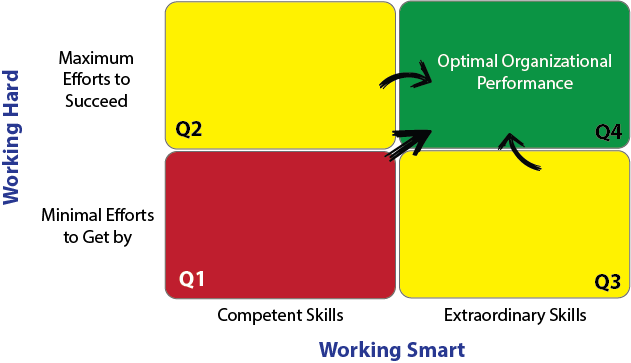Every Monday morning around the world, in millions of business offices, a version of the following  conversation can be heard.
conversation can be heard.
“How was the weekend?”
“It was ok, I spent most of it working for like the third weekend in a row just to catch up. It feels like we work and work, but can’t get anything accomplished.”
The conversation then turns into a pity party about all the obstacles, issues, and challenges the company has, and how everyone must work extra hard to get anything done.
Sound familiar?
Based on years of working with hundreds of business organizations, I believe that most companies can’t achieve optimal organizational performance because the leaders and “hard workers” of the company don’t have the Business Acumen skills needed to work both hard and smart at the same time to achieve optimal organizational success.
In the matrix below, I present four quadrants that are created by two axes; “Working Hard” and “Working Smart.”
Quadrant One is the most difficult quadrant, but one I believe can move to Quadrant Four with an organizational transformation to embrace business acumen skills.
Quadrant Two is the situation where leaders and employees are trying hard, but they don’t have the skills needed to achieve optimum organizational performance. With a learning intervention, this can occur rapidly.
Quadrant Three is the situation where there are strong skills, but the is a leadership issue that is blocking the way for engagement and motivation.
Quadrant Four is where all organizations want to be; working hard and working smart. The challenge is to find the methods and tools to maintain that achievement.

Business Acumen is defined as having the skills and tools to understand how a company makes money through the leadership of people. It includes a system understanding of strategic thinking, financial management, marketing, sales, supply chain, R&D, and operations.
Below are a few ideas for each of the quadrants in terms of embracing the business acumen skills needed to achieve optimum organizational performance.
Quadrant One
A complete organizational transformation to integrate business acumen in to the culture is needed. The best way for that to happen is to start in the middle and then simultaneously work up to senior managers and executives, and down to first-line managers and employees. There are tools that exist today to create learning journeys that include the integration of eLearning, virtual classrooms, webinars, business simulations, and SimBot coaches to help build the skills needed to set and execute strategy through people.
Quadrant Two
In quadrant two, the organization works hard, but not smart. Based on our experiences, one of the primary reasons the organization doesn’t work smart is that most mid-level managers and most employees don’t understand the strategy, the decisions needed to execute the strategy, or the financial metrics that support the strategy. The best organizations in the world move from quadrant two to quadrant four by implementing foundational and advanced Business Acumen programs virtually, online, and in live instructor-led sessions that feature a variety of tools such as computer-based business simulations.
Quadrant Three
In quadrant three, the organization works smart, but does the minimal in terms of work effort to achieve optimal organizational performance. They cut corners and to only the minimal to get by. This is an organization where people show up at 9 and leave by 5. Most organizations that reflect these behaviors typically don’t’ have the business acumen skills to communicate the strategy and then motivate people to execute the strategy that will achieve financial goals and objectives. One of the best ways of engaging these types of employees is through interactive learning such as Business Acumen simulations that have leaderboards and badges of success so employees can learn, have fun, and develop their competitions.
Quadrant Four
Quadrant four is where all organizations want to be. But even if you get there, you must continue to develop and reinforce the Business Acumen skills. On-demand Business Acumen eLearning and virtual business simulations are great tools to reinforce skills and evolve skills as the business world changes around you.




